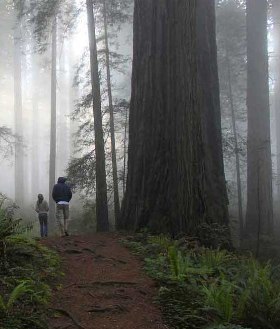Photo by: Christopher Schroeer-Heiermann

California's ancient Redwoods have survived floods, fires and the logger's axe, but the impact of global warming is still a big question mark.
What will climate change mean for the sequoias of the Southern Sierra and the Coast redwoods up north?
An unconventional experiment is taking place high above the ground in the branches of giant sequoias in the Whitaker Forest near Kings Canyon National Park.
"Just spent the day crown mapping or branch mapping," says researcher Russell Kramer.
Researchers from UC Berkeley, Davis and Humboldt State have come together to study the giants. They are taking careful measurements and using special cameras to take photos of the branches high up in these trees. They will count the leaves and measure the branches.
"You got to hold it in position while you whip out your compass with the other hand, and one-handedly get the measurement," Kramer says.
They are hoping to determine whether global warming is having an impact on the last remaining groves of redwoods in the world. Anthony Ambrose is one of the tree-climbing researchers.
"It's critical to get up into the trees because that's where all the action is happening, that's what's going on in the tree. In order to understand the tree and what's it's doing and how it's growing, it's structure, and its function, we need to get up there. You can't just study these trees from the ground," he says.
Two centuries of logging decimated old-growth Redwoods. The ancient trees once covered large portions of Northern California. Today, only about 5 percent of the original forest is left.
Over the next three years, the team will branch out and climb the huge sequoias and immense redwoods at 13 locations around the state, as part of a $2.5 million project. We caught up with the researchers recently in Humboldt County and that's where they launched the "Redwoods and Climate Change Initiative."
The goal is to answer one key question.
"What's the future of these trees, the giant sequoia and coastal Redwoods in a changing world?" asks Ruskin Hartley, executive director with Save the Redwoods League.
The league is a non-profit dedicated to preserving the great trees.
"We need to understand the past of these trees, we need to understand how they are functioning today so that we can make smart decisions about how we can serve them in the future," Ruskin says.
"Climate change is happening now," says UC Berkeley professor Todd Dawson. "It's not one of those things that we are looking to happen in the future, and if we don't start working on finding solutions now, you know, these ecosystems, these trees, these species of all kinds, are going to be gone."
The study has already yielded some interesting results.
"We are finding that trees that are over 1,500 years old are growing more than they have in their history, and that is completely unpredicted from basic scientific understanding about what happens to old forest and old trees," Dawson.
They have also found evidence of decreased fog where Coastal redwoods grow and fluctuations in the amount of water that is being lost and absorbed by tree leaves. Core samples are another important tool in understanding the life of these trees.
"If you do that at base height, you only get a limited view of the tree," says one researcher from Humboldt State University.
Getting samples from high up in the trees used to mean waiting for them to fall.
Now researchers say, "The key to cross-dating redwood, the key to the tree rings and having samples that have stronger patterns, more representative rings, is going up in the tree."
Tree rings can uncover things like past humidity, rainfall, fog and temperature. To keep tabs on future readings, they are also installing sensitive monitoring equipment.
"We put these sensors in the trees to monitor climatic conditions, and then we can also monitor things like the flow of water through the tree," says Humboldt State University professor Stephen Sillett.
Ideally, the team hopes to eventually streamline the boxes into smaller devices that will be placed on treetops throughout forests.
"This is a wireless microclimate sensor," Sillet explains. "It will measure light, humidity, air temperature, barometric pressure, and it will enable you to quantify the climate that the trees experiencing wherever you put this device."
Using the data collected, scientists hope to be able to preserve what is left of the magnificent giants for future generations.
The project is being funded by Bay Area billionaire Ken Fisher, who studied forestry and economics at Humboldt State. He has offered to match contributions up to $500,000. If you would like to help, visit the Save the Redwoods League website.
Read the story at the source.
